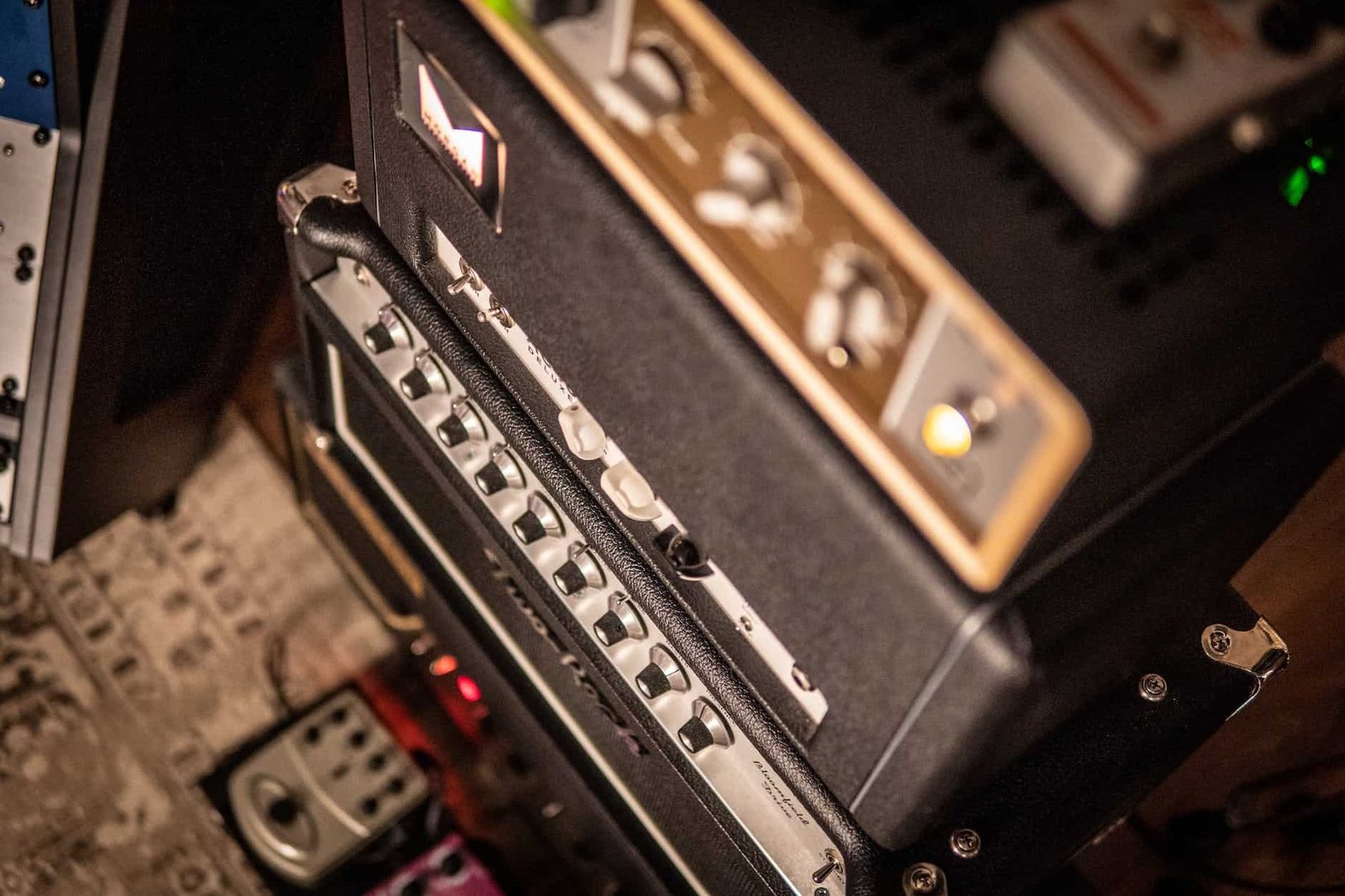As a seasoned guitar player who has spent years testing various gear, I can tell you that finding the right guitar amp as a beginner isn’t easy. You are not just looking for something that sounds good – you want it to be affordable, user-friendly, and suited for the type of music you enjoy playing.
In my quest to simplify this process for beginners, I have chosen five top-notch guitar amps which strike the perfect balance between functionality, affordability, and sound quality. Let’s dive into my recommendations!
Contents
Fender Mustang LT25: A Budget-Friendly Sound Explorer
Fender Mustang LT25 is my top pick if you’re searching for an amp that won’t burst your budget but still allows room for tonal exploration. It offers diversity in its built-in effects and models which lets beginners experiment with various tones. From classic rock and blues to hard-hitting metal, whatever your preference may be, this amp won’t disappoint.
I’ve seen many novices struggle with complex settings when they could playfully strum chords instead. That’s why I admire Fender Mustang LT25 – its user-friendly interface makes it effortless even for non-techies to navigate through different presets and tweaks without reading lengthy manuals.
In my college days, there were incidents where my unplanned late-night jam sessions faced major backlash from roommates! Generally speaking, sounding too loud especially when others need silence is not well received (trust me!). The headphone output feature in this amp helps solve such social dilemmas while being cool at what you do!
It also provides connectivity via USB which unlocks access to Fender’s Tone App where you can create or download new presets shared by other users globally.
Marshall MG10G: When Power Meets Compactness
Guessing rightly about how much love novice players have for small-sized amps lead me onto our next contender – Marshall MG10G. Though petite in stature it outrivals many larger counterparts in terms of power delivery. Its 6.5-inch speaker does a noteworthy job of generating
full and balanced sound that can easily fill a small room.
I fondly recall when I first began guitar lessons, my beginner amp had switches for clean and overdrive sounds. This allowed me to switch from pure, clear tones to distorted rock feels at the flip of a button – it felt like magic! Similarly, Marshall MG10G sports two channels, Clean and Overdrive which you can alternate between with just one press.
Using this amp is plain sailing too as it has easily-adjustable controls – Gain, Volume, Bass, Middle, and Treble. Plus it offers an auxiliary input letting you play along to your favourite tracks- just another fun way to practice!
Boss Katana Mini: Power House on the Go
Up next we have the pocket-sized power performer – Boss Katana Mini! Although small in size, this tiny titan does quite a heavy lifting in delivering rich sound output. With power up to 7-watt, it’s fitting both for at-home practices or outside usage.
Incorporating effects into your tones adds an entirely new layer of sonic dimensionality. The built-in delay effect in this amp gives precisely that professional-sounding touch whether you prefer subtle ambiance or pronounced echoes. Its stand also doubles as a hostel for cords and cables while boosting projection!
Orange Crush 12: Revisiting Vintage Hues
Another affordable option on the list presents nostalgia blended with raw energy – Orange Crush 12! It takes me back down memory lane reminiscing classic rock times by creating similar vintage vibes for beginners today.
This compact piece exhibits a user-friendly control layout making it easier for beginners to fine-tune their desired tone almost instantly! From my experience practicing music during odd hours requires quieter solutions- the headphone output feature becomes not only useful but also respectful towards others’ peace.
One charming afternoon while picnic-ing in our local park last summer my niece decided she wanted us all to perform some good ol’ tunes together while connecting her tablet – thankfully Crush 12 features an auxiliary input. The park rocked 🙂
Yamaha THR5: Packed With Style And Diversity
If you fancy sleek designs and a diverse tonal range then ladies and gentlemen – presenting the Yamaha THR5! Aesthetically pleasing yet, equally versatile this amp has all it takes to leave an aspiring guitarist surprised every time they play!
What stands out for me among THR5’s features is its five different amp types which allow players to strike various tones and styles. Its modulation, delay, and reverb effects are added perks that moreover enable sound enhancement making your guitar sing more creatively. On days when I’m away from my studio or traveling, this humble size device emerges as a splendid silent companion thanks to its AC mode or battery setup options.
Choosing An Amp – Things To Keep In Mind
Finding your perfect beginner amp could seem overwhelming at first but here are a few tips on what factors you should be mindful of:
- Wattage: Wattage selection largely depends upon where you’ll mostly be playing. For instance, home-based practicing normally requires lower wattages whereas jam sessions or gigs might require more power.
- Speaker Size: Smaller speakers suit practice and home use well but larger variants offer increased volume ability accompanied with fuller sounds.
- Built-In Effects: Amps featuring built-in effects like delay settings, reverb, etc become handy when one wants to experiment with different sound variations avoiding additional pedal requirements.
- Headphone Output Subsequent nocturnal training while flatmates are sleeping? Try using headphone-enabled amplifiers for quiet practice without causing a nuisance.
- Budget Friendly: Ascertaining how much you wish to invest is crucial too since there exist quality choices suiting every price bracket.
Sound Quality Matters
Sound reproduction’s accuracy decides any amp’s real worth because it lets a player hear their progress most transparently therefore making it a note-worthy point when semi-finals of the high school competition began we had a contestant friend whose rich transitioning chords got lost during his performance due to terrible sound termination
of the venue’s amp. Hence, having a quality personal guitar amplifier becomes imperative to avoid such mishaps.
From my own journey of striking chords to creating symphonies, I can attest that good amplification not only aids in highlighting errors but also encourages continued play by making you fall in love with the sound you produce. Therefore, investing wisely in your first amp can go a long way in shaping your musical dreams.
Deciphering Types Of Guitar Amplifiers
There’s variety when it comes to availabilities of guitar amps targeting different players as per their needs and preferences:
- Tube Amps: Known for their warm and organic sound delivery using vacuum tubes. They support rich tones and natural overdrive getting the popular vote from many.
- Solid-State Amps: As compared to the former ones these are more affordable offering clean consistent sounds working through transistors perfect choice for beginners.
- Digital Modeling Amps: Enabled with digital technology simulating varied models at disposal these facilitate wider playful tonal exploration great start for enthusiastic rookies.
Each category delivers a unique set of benefits hence trying out each type before choosing is usually an advisable approach.

Setting Up Your New Guitar Amp
Congratulations on finding a compatible amp! Here are some pro tips for ensuring the best possible sound output:
- Nail the Basics: Start adjusting controls (gain, volume, bass, etc.) around halfway for a neutral starting point and progress from thereon.
- Play Around Gain Settings: Lower gain assists a clear style while increasing can contribute towards distortion depending upon the requirement.
- Curate Sound Via EQ: Utilize bass or treble control maximizing desired results by experimenting with room acoustics too.
- Understanding Built-In Effects: In case of reverb/delay or other incorporated effects, try playing around till you find what works best for your preference don’t forget subtle tweaking goes much farther!
- Last But Not Least Trust Ears! In the end, if sounds right, it isn’t wrong 🙂 Remember, every amp has a signature therefore allowing our ears to decide often proves more effective than depending on review ratings
.
Amp Care & Maintenance Tips
Your guitar amp, much like your six-string best friend, needs care and maintenance to always sound its best. Here’s how you can keep it in top condition:
- Cleanliness is Key: Use a soft cloth to wipe off any dust or fingerprints from the exterior. Always remember to switch off and unplug the amp before cleaning.
- Avoid Extreme Conditions: Stay clear of moisture, direct sunlight, or chilly rooms to prevent any potential harm to its internal parts.
- Handle with Caution: Jarring movements can damage delicate components so always tote it around gently.
- Maintenance of Tubes (Only if applicable): Tube amps require periodical tube replacements due to natural wear and tear. For safe replacement procedures, do refer to accompanying guidelines or consult professionals.
- Troubleshooting Steps: Unusual noises or functionality issues call for troubleshooting as per the manufacturer’s manual but if trouble prevails please contact an authorized technician immediately.
Looking after your amp not only extends its life span but ensures continued clear buzzing sounds hence taking time out for these will surely be worth it!
Frequently Asked Questions
Q: How long does learning guitar usually take?
A: Time required varies greatly depending on personal discipline & regularity factors affecting progress. Here is a great article on how long it takes to learn guitar.
Q: Can these amps be used specifically for both electric and acoustic guitars?
A: No they are designed to cater to the requirements of electric guitars mainly.
Q: Are the recommended amps suitable for playing live performances?
A: Not exactly. These amps are primarily meant for beginners and thus might lack the power projection needed for professional scenarios thereby making them more suitable for practice and small-scale performances.
Q: Can these amps be connected to a computer for recording or using amp modeling software?
A: Unfortunately, these are not designed with the complexity required to connect directly to computers for recording purposes or software usage.
Wrapping up
As a novice, embarking on this journey with the right guitar amp is crucial. The amps in my list give you an affordable yet quality start – regardless of the music genre you prefer.
The Fender Mustang LT25 stands out due to its versatility coupled with affordability. If size and power are your prime concerns, consider the small but mighty Marshall MG10G or the mobile wonder that is the Boss Katana Mini.
Fans of vintage style would appreciate the warm sounds from the classic rock star – Orange Crush 12, whereas if a stylish design with varied tone options excites you then take a look at Yamaha THR5.
Remember, starting out with guitar inevitably has its own challenges, but, believe me when I say – investing in a quality amplifier could be that game changer that made me fall head over heels in love with playing guitars. And I promise it’ll do the same for you. Keep practicing and always enjoy your strumming!
